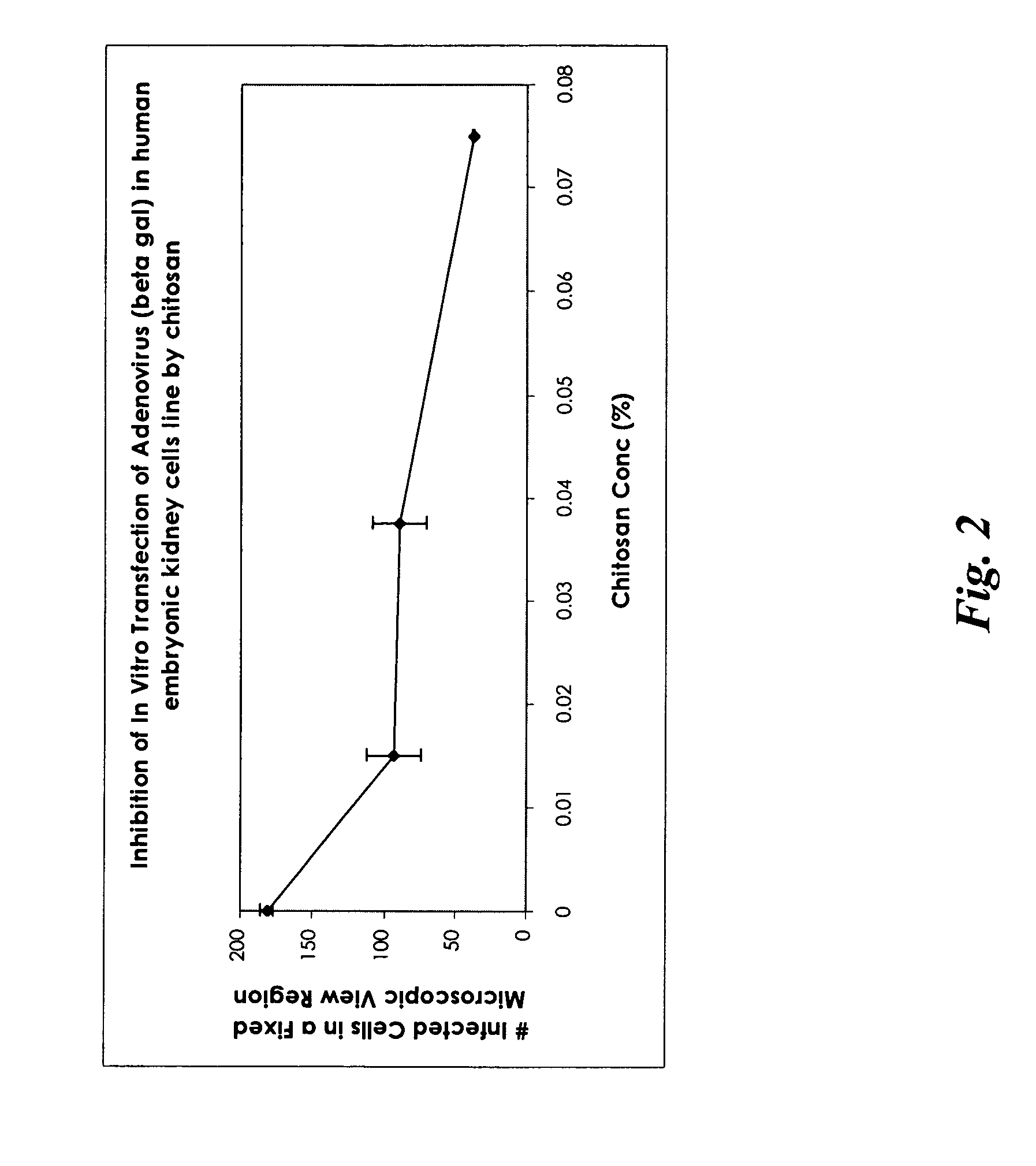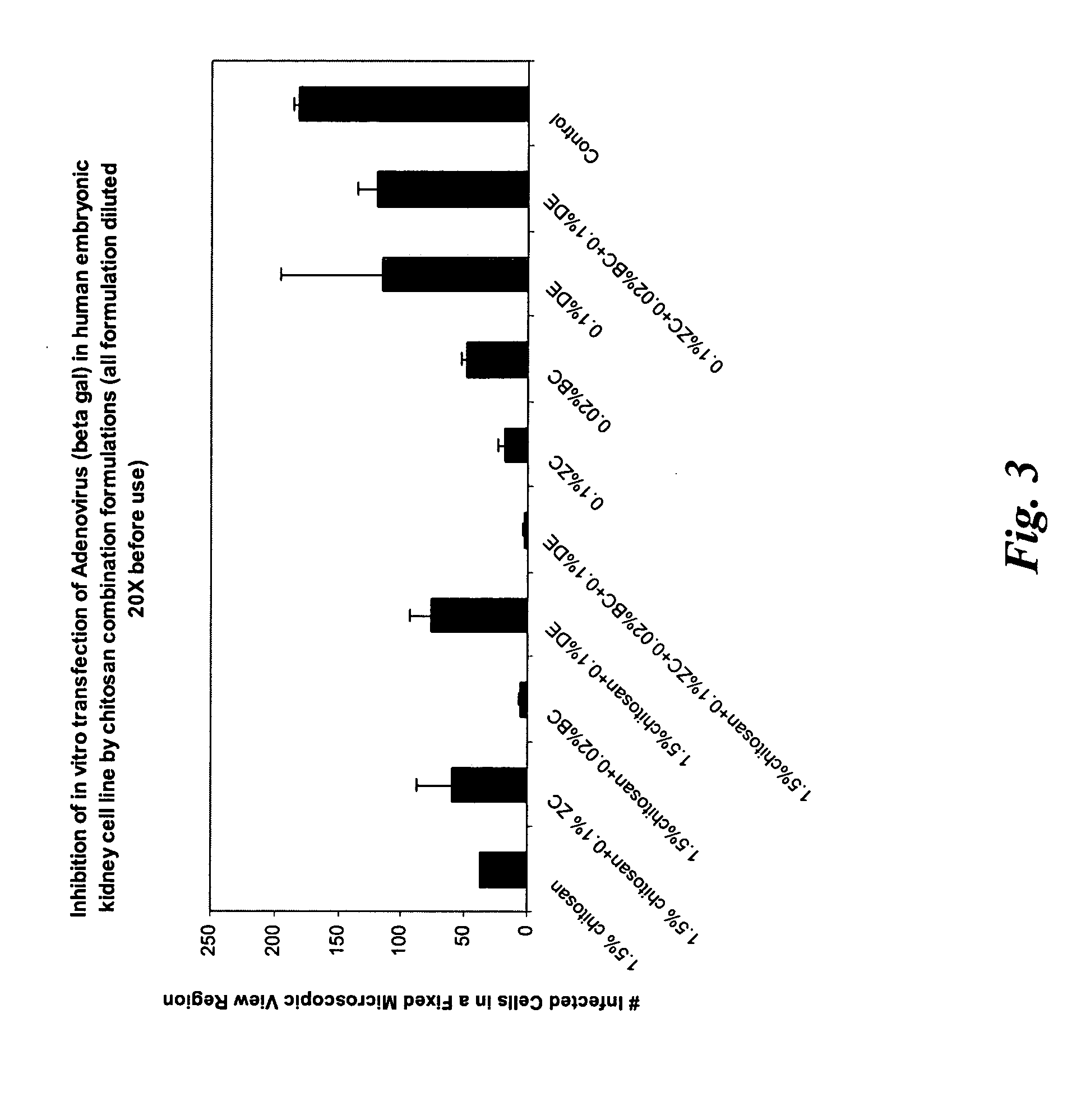Anti-viral pharmaceutical compositions
a technology of pharmaceutical compositions and antiviral agents, applied in the field of antiviral agents, can solve the problems of undesirable effects, low antiviral activity, and inability to recommend high doses of vitamin c in children
- Summary
- Abstract
- Description
- Claims
- Application Information
AI Technical Summary
Benefits of technology
Problems solved by technology
Method used
Image
Examples
example 1
[0116] The composition shown in Table 1.1 was comprised of 1.5% (w / w) chitosan hydrochloride salt, 0.1% (w / w) zinc chloride, 0.02% benzalkonium chloride, and 98.38% (w / w) water. The formulation of such composition was prepared by mixing all three of the cationic components in the aqueous phase (water) and stirring to dissolve them completely at room temperature. Since both zinc chloride and benzalkonium chloride were in the salt form, their dissolution process was rapid. As for chitosan, its solubilization process was gradual. The final formulation prepared was in a form of a gel.
TABLE 1.1Component% by weightChitosan hydrochloride1.50%Zinc chloride0.10%Benzalkonium chloride0.02%Water98.38%pH 4.5-6.5
[0117] The formulation in the form of a gel prepared in such a manner was tested in vitro for its effective anti-viral activity using adenovirus as the target virus. It was found that the gel exhibited a greatly increased anti-viral effect synergistically: The gel showed much stronger a...
example 2
[0120] A formulation in the form of a gel was prepared (in a similar manner as described in Example 1) using only chitosan and was tested in vitro for its effective anti-viral activity using adenovirus carrying beta galactosidase gene as the target virus in human embryonic kidney cell line. The concentration of chitosan was 1.5% (w / w) with 98.5% water (w / w) in the formulation. Before applying such a gel formulation to the cell line culture, the gel formulation was diluted to obtain three chitosan concentrations of 0.015%, 0.0375%, and 0.075% (w / w) prior to treating the infected human embryonic kidney cells in the cell culture medium. A blank control (no chitosan added) was used for comparison. The results, summarized as the number of infected cells in a fixed microscopic view region as a function of chitosan concentration, are presented in FIG. 2.
[0121] The results show that chitosan alone possessed certain level of anti-viral activity; the number of infected cells decreased with t...
example 3
[0122] A series of formulations were prepared (in a similar manner as described in Example 1) with various combinations of zinc chloride, chitosan, benzalkonium chloride and disodium edetate as preservatives. The formulations were tested in vitro for its effective anti-viral activity using adenovirus (beta galactosidase) as the target virus in human embryonic kidney cell line. A blank control (no anti-viral agent added) was used for comparison. For the formulations containing chitosan, its concentration was 1.5% (w / w). Before applying the formulations to the infected human embryonic kidney cell line culture, those formulations containing chitosan were diluted to obtain a chitosan concentration of 0.075% (w / w), which was found to be the most effective concentration in inhibiting adenovirus infection in Example 2. Others were diluted by 20 times before application. The formulation designs were given Table 3.1.
TABLE 3.1Formulation (%, w / w)Components123456789CChitosan1.51.51.51.51.5——...
PUM
| Property | Measurement | Unit |
|---|---|---|
| composition | aaaaa | aaaaa |
| concentration | aaaaa | aaaaa |
| water soluble | aaaaa | aaaaa |
Abstract
Description
Claims
Application Information
 Login to View More
Login to View More - R&D
- Intellectual Property
- Life Sciences
- Materials
- Tech Scout
- Unparalleled Data Quality
- Higher Quality Content
- 60% Fewer Hallucinations
Browse by: Latest US Patents, China's latest patents, Technical Efficacy Thesaurus, Application Domain, Technology Topic, Popular Technical Reports.
© 2025 PatSnap. All rights reserved.Legal|Privacy policy|Modern Slavery Act Transparency Statement|Sitemap|About US| Contact US: help@patsnap.com



